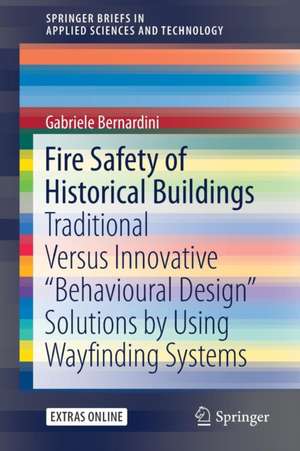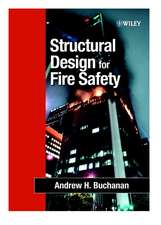Fire Safety of Historical Buildings: Traditional Versus Innovative “Behavioural Design” Solutions by Using Wayfinding Systems: SpringerBriefs in Applied Sciences and Technology
Autor Gabriele Bernardinien Limba Engleză Paperback – 26 apr 2017
Firstly, critical issues for Building Heritage fire safety are widely discussed, by including the modelling of human factor and man-environment-fire interference in these architectural spaces. A significant part of the book includes a discussion on emergency modeling and simulation. A source code for representing the fire evacuation process (including man-evacuation facilities interactions) is offered to the reader.
Methods for effectiveness assessment of risk-reducing solutions are provided and tested in a case-study. Being a structured approach to occupants-related problems during a fire in heritage buildings, it offers an innovative methodology and practical examples that researchers and designers can use as a guide when proposing and testing solutions. Evaluation indexes for effectiveness assessment (also useful for future guidelines or handbooks) are included. Readers are encouraged to understand these indexes within the proposed approach, so as to extend their applications and possibilities of how to introduce human behaviors-based solutions in other fields.
Lastly, attention is focused on the proposal and evaluation of low-impact and not-invasive strategies, such as ones based on wayfinding elements. From this point of view, the pros and cons of wayfinding systems are discussed: these are important today, especially for fire-safety designers, because of the ongoing innovations in this field.
Din seria SpringerBriefs in Applied Sciences and Technology
-
 Preț: 380.29 lei
Preț: 380.29 lei - 17%
 Preț: 360.34 lei
Preț: 360.34 lei - 20%
 Preț: 386.12 lei
Preț: 386.12 lei -
 Preț: 380.07 lei
Preț: 380.07 lei -
 Preț: 377.95 lei
Preț: 377.95 lei -
 Preț: 382.32 lei
Preț: 382.32 lei -
 Preț: 376.59 lei
Preț: 376.59 lei -
 Preț: 379.09 lei
Preț: 379.09 lei -
 Preț: 378.12 lei
Preț: 378.12 lei - 20%
 Preț: 293.83 lei
Preț: 293.83 lei -
 Preț: 344.90 lei
Preț: 344.90 lei -
 Preț: 321.36 lei
Preț: 321.36 lei -
 Preț: 264.79 lei
Preț: 264.79 lei -
 Preț: 344.90 lei
Preț: 344.90 lei -
 Preț: 356.46 lei
Preț: 356.46 lei -
 Preț: 382.95 lei
Preț: 382.95 lei -
 Preț: 355.66 lei
Preț: 355.66 lei -
 Preț: 479.67 lei
Preț: 479.67 lei -
 Preț: 415.18 lei
Preț: 415.18 lei -
 Preț: 444.52 lei
Preț: 444.52 lei - 20%
 Preț: 301.86 lei
Preț: 301.86 lei -
 Preț: 409.43 lei
Preț: 409.43 lei - 20%
 Preț: 322.17 lei
Preț: 322.17 lei -
 Preț: 355.49 lei
Preț: 355.49 lei - 15%
 Preț: 462.51 lei
Preț: 462.51 lei -
 Preț: 377.18 lei
Preț: 377.18 lei -
 Preț: 355.93 lei
Preț: 355.93 lei -
 Preț: 382.95 lei
Preț: 382.95 lei -
 Preț: 378.12 lei
Preț: 378.12 lei -
 Preț: 378.12 lei
Preț: 378.12 lei -
 Preț: 380.07 lei
Preț: 380.07 lei -
 Preț: 380.07 lei
Preț: 380.07 lei - 20%
 Preț: 326.28 lei
Preț: 326.28 lei -
 Preț: 312.68 lei
Preț: 312.68 lei -
 Preț: 356.43 lei
Preț: 356.43 lei -
 Preț: 412.30 lei
Preț: 412.30 lei - 20%
 Preț: 225.31 lei
Preț: 225.31 lei -
 Preț: 378.12 lei
Preț: 378.12 lei -
 Preț: 376.59 lei
Preț: 376.59 lei -
 Preț: 195.87 lei
Preț: 195.87 lei -
 Preț: 376.22 lei
Preț: 376.22 lei - 20%
 Preț: 324.64 lei
Preț: 324.64 lei - 20%
 Preț: 288.73 lei
Preț: 288.73 lei -
 Preț: 377.57 lei
Preț: 377.57 lei -
 Preț: 261.91 lei
Preț: 261.91 lei -
 Preț: 381.98 lei
Preț: 381.98 lei -
 Preț: 273.64 lei
Preț: 273.64 lei -
 Preț: 410.87 lei
Preț: 410.87 lei -
 Preț: 379.68 lei
Preț: 379.68 lei -
 Preț: 374.30 lei
Preț: 374.30 lei
Preț: 411.54 lei
Nou
Puncte Express: 617
Preț estimativ în valută:
78.76€ • 85.52$ • 66.16£
78.76€ • 85.52$ • 66.16£
Carte tipărită la comandă
Livrare economică 22 aprilie-06 mai
Preluare comenzi: 021 569.72.76
Specificații
ISBN-13: 9783319557434
ISBN-10: 3319557432
Pagini: 109
Ilustrații: XII, 109 p. 20 illus., 3 illus. in color.
Dimensiuni: 155 x 235 x 7 mm
Greutate: 0.19 kg
Ediția:1st ed. 2017
Editura: Springer International Publishing
Colecția Springer
Seria SpringerBriefs in Applied Sciences and Technology
Locul publicării:Cham, Switzerland
ISBN-10: 3319557432
Pagini: 109
Ilustrații: XII, 109 p. 20 illus., 3 illus. in color.
Dimensiuni: 155 x 235 x 7 mm
Greutate: 0.19 kg
Ediția:1st ed. 2017
Editura: Springer International Publishing
Colecția Springer
Seria SpringerBriefs in Applied Sciences and Technology
Locul publicării:Cham, Switzerland
Cuprins
Introduction.- Fire safety and building heritage: the occupants' perspective.- How to increase occupants' safety with no architectural modifications: defining effective wayfinding systems.- Applications to a case study: fire safety in historical theaters.- Conclusions and perspectives.- Appendix.- Glossary.- Solutions.
Textul de pe ultima copertă
This book applies a behavioral point of view to individuals’ fire safety in historic buildings. It outlines theoretical and operative issues, based on recent studies and international guidelines.
Firstly, critical issues for Building Heritage fire safety are widely discussed, by including the modelling of human factor and man-environment-fire interference in these architectural spaces. A significant part of the book includes a discussion on emergency modeling and simulation. A source code for representing the fire evacuation process (including man-evacuation facilities interactions) is offered to the reader.
Methods for effectiveness assessment of risk-reducing solutions are provided and tested in a case-study. Being a structured approach to occupants-related problems during a fire in heritage buildings, it offers an innovative methodology and practical examples that researchers and designers can use as a guide when proposing and testing solutions. Evaluation indexes for effectiveness assessment (also useful for future guidelines or handbooks) are included. Readers are encouraged to understand these indexes within the proposed approach, so as to extend their applications and possibilities of how to introduce human behaviors-based solutions in other fields.
Lastly, attention is focused on the proposal and evaluation of low-impact and not-invasive strategies, such as ones based on wayfinding elements. From this point of view, the pros and cons of wayfinding systems are discussed: these are important today, especially for fire-safety designers, because of the ongoing innovations in this field.
Firstly, critical issues for Building Heritage fire safety are widely discussed, by including the modelling of human factor and man-environment-fire interference in these architectural spaces. A significant part of the book includes a discussion on emergency modeling and simulation. A source code for representing the fire evacuation process (including man-evacuation facilities interactions) is offered to the reader.
Methods for effectiveness assessment of risk-reducing solutions are provided and tested in a case-study. Being a structured approach to occupants-related problems during a fire in heritage buildings, it offers an innovative methodology and practical examples that researchers and designers can use as a guide when proposing and testing solutions. Evaluation indexes for effectiveness assessment (also useful for future guidelines or handbooks) are included. Readers are encouraged to understand these indexes within the proposed approach, so as to extend their applications and possibilities of how to introduce human behaviors-based solutions in other fields.
Lastly, attention is focused on the proposal and evaluation of low-impact and not-invasive strategies, such as ones based on wayfinding elements. From this point of view, the pros and cons of wayfinding systems are discussed: these are important today, especially for fire-safety designers, because of the ongoing innovations in this field.
Caracteristici
Includes FDS+EVAC modified source code for simulating individuals' wayfinding issues Describes practical examples of systems that can improve people safety in buildings Helps in designing human behaviors-based solutions in architectural spaces Offers non-invasive solutions to building heritage safety Provides indexes for evaluating safety performance of Building Heritage Includes supplementary material: sn.pub/extras












